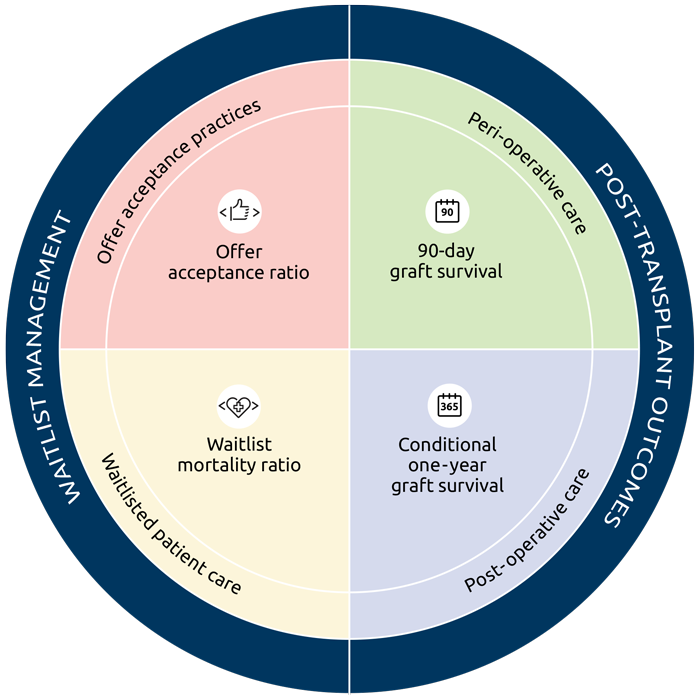Improvement
“Our cosmic goal”: Enhancing transplant metrics and increasing transplant
MPSC chair Ian Jamieson on transforming and improving transplant performance metrics.

“Our root intent – our cosmic goal – is to increase the volume of transplants in a safe and efficient manner, without lessening outcomes or reducing organ utilization.”
Ian Jamieson, chair of the OPTN Membership and Performance Standards Committee
The need
MPSC: A partner in improvement
What will the new metrics be?
“Now is the time to make this change,” Jamieson says. “We are asking the community to be engaged now, because it could be a number of years before we get another chance. This project is important, and we can’t let perfect be the enemy of good.” Public comment is open through Sept. 30.
At-a-glance: the MPSC transplant program performance project
- The current single metric approach needs to be improved—transplant programs are graded solely on whether a graft functions for a full year.
- The MPSC is proposing to use both pre- and post-transplant metrics to monitor performance, in a more patient-centered approach.
- These changes present a paradigm shift, but will utilize metrics that already exist, and that members can influence through quality improvement.
- The metrics will be risk-adjusted—this allows the MPSC to account for differences in patients and donors in order to make a more valid comparison of other factors, such as treatment practices. Learn more about risk adjustment.
- The new approach will not result in more programs having to interact with the MPSC.
- The transplant community gets to provide feedback during fall 2021 public comment and help shape the proposed new metrics.
- The SRTR’s 5-tier outcome assessments are not part of the proposal.
- There is nobody better positioned to develop more holistic performance monitoring than the professionals who work every day to save lives through transplantation.
The need to develop better metrics
For many years, the MPSC has used a single post-transplant metric – one-year patient and graft survival – to monitor program performance. Jamieson describes this metric as outdated and a disincentive to transplantation. The proposed new metrics would include pre-transplant metrics as well as post-transplant measures. “We believe a holistic review of a transplant program is far better than looking at a static post-transplant survival metric.”
In August, Jamieson collaborated with Jon Snyder, Ph.D, Director of the Scientific Registry of Transplant Recipients, to record an hour-long deep dive into the proposed evaluation measures. The SRTR works with UNOS as the OPTN contractor and provides analytic support in policy development and performance monitoring. The SRTR also evaluates the performance of the system through regular publication of reports. Snyder provided an extensive explanation of the metrics for the community.
A window of opportunity
Jamieson says the community generally agrees that there is a need for new metrics for program performance. “And importantly, there’s universal agreement that it should be us, the transplant community, who makes these metrics – they should not be imposed on us by another body. We are the only ones who truly understand our practice.”
“We really want to take advantage of this window of opportunity to help our patients across pre- and post-transplant phases, and also control our own destinies as transplant professionals,” he says. “Our root intent – our cosmic goal – is to increase the volume of transplants in a safe and efficient manner, without lessening outcomes or reducing organ utilization.”
MPSC: A partner in improvement
A transplant administrator for nearly 30 years, Jamieson has been involved in OPTN committee work for almost two decades, starting as a regional representative on the Transplant Administrators Committee, which he eventually chaired. After serving on the MPSC a decade ago, Jamieson started his two-year term as committee chair in July 2020.
When asked to describe the committee’s work, Jamieson stresses that the MPSC is a peer organization. “We’re here to assist transplant programs in improving their processes, and we have an oversight responsibility to ensure patient safety and that the broader transplant community is confident in the system that manages these important societal resources.” He says there has been a significant effort within the MPSC to become a more process-improvement driven and collaborative body.
While the transplant metrics project is foremost in his mind at the moment, Jamieson is also keen to talk about succession planning at transplant programs. “It’s extremely important to spend the time to identify those within your program who meet OPTN criteria and can step in if something changes, so that transitions are very straightforward.”
The MPSC has been focused on this project for more than a year and a half, and Jamieson emphasizes how impressed he is by and how thankful he is for the devotion the committee members have demonstrated to the project. “They all have busy professional lives and the fact that they have chosen to spend countless hours on this underlines how important it is.”
The proposed metrics
For many years, the MPSC’s monitoring of transplant programs has relied on a single data point—one-year post-transplant patient and graft survival (whether a transplanted organ works for a full year).
As Formica outlined in the June 2 webinar, the MPSC proposes to use four different pre- and post-transplant metrics—all risk-adjusted—to monitor transplant program performance:
- Offer acceptance: A program’s rate of accepting organ offers relative to the expected based on similar offers across the nation.
- Waitlist mortality: A program’s waitlist mortality rate relative to the mortality rate experienced by similar patients across the nation.
- 90-day graft survival hazard ratio: In the first 90 days post-transplant, a graft is counted as failed if there has been graft failure or death.
- One-year graft survival conditional on 90-day graft survival hazard ratio: After the patient has been released to longer-term post-transplant care, a graft is counted as failed if there has been graft failure or death.

The MPSC released their proposal to enhance the transplant program performance monitoring system for public comment on Aug.3, 2021. All proposals this cycle are open for public comment through Sept. 30, 2021, on the OPTN public comment page. During the two-month public comment period, the community is invited to provide feedback and input about the proposed changes to transplant program performance monitoring.
Do you have questions about the MPSC performance monitoring project?
Please contact Sharon Shepherd at [email protected].
What is the MPSC?
The OPTN Membership and Performance Standards Committee is a performance partner, providing feedback on and recommendations to members to help them improve.
MPSC: who they are and what they do
- Has oversight responsibilities aligned with the OPTN mission to maximize organ supply, ensure patient safety, and provide equitable access to transplantation, and it needs the best tools to do this work.
- Reviews applications for membership in the OPTN, approvals of designated transplant programs and changes in OPTN member key personnel.
- Works to safeguard the integrity of the transplant system and helps OPTN members reach their maximum potential.
- Monitors member performance using data from the Scientific Registry of Transplant Recipients.
“We believe a holistic review of a transplant program is far better than looking at a static post-transplant survival metric.”
Ian Jamieson







